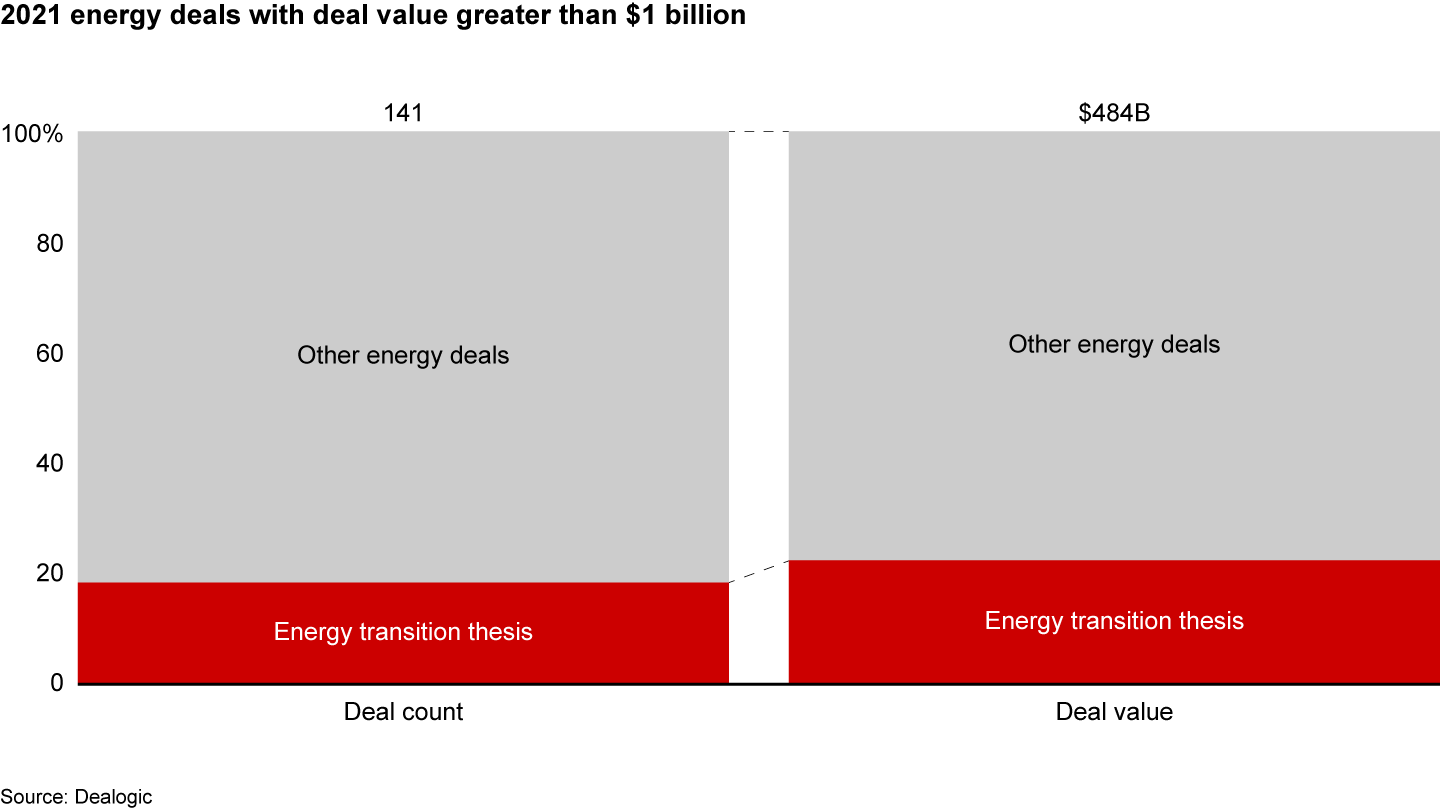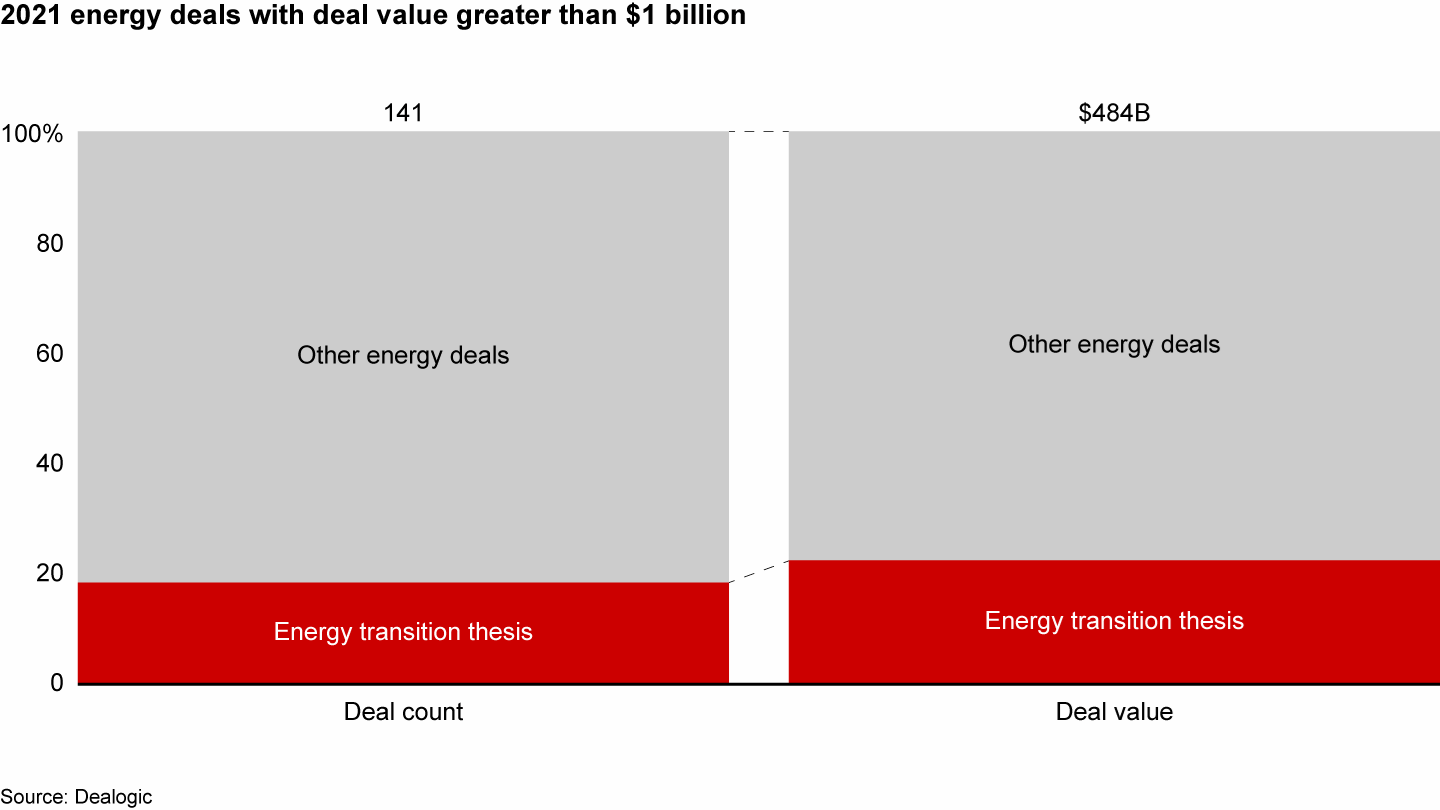M&A Report

At a Glance
- Despite low deal activity in 2021, more companies will turn to M&A to make more progress on the energy transition that will hasten them to a lower-carbon, sustainable future.
- Energy transition deals accounted for about 20% of all energy sector deals greater than $1 billion in 2021.
- In 2022, more companies will use deals to green existing operations and strengthen environmental, social, and corporate governance assets; build green energy hubs; build an integrated value chain to deliver energy transition products and services; reshape business models; and invest in start-ups to acquire disruptive technology.
This article is part of Bain's 2022 M&A Report.
M&A activity in the energy and natural resources industry saw continued lows in 2021, rebounding only around 20% when compared with 2020 and not yet recovering to pre-pandemic levels. Partly, this was the result of companies looking for demand to stabilize. Then, as stabilization largely took place, a second factor came into play: Companies began sharpening their capital discipline, which slowed dealmaking as fewer deals met their higher hurdle rates.
We believe that conditions are primed for an upswing propelled by a resurgence in industry consolidation and portfolio management. The oil and gas industry remains highly fragmented in many sectors, and multiples remain depressed, setting the stage for consolidation to unlock new levels of efficiency. Meanwhile, there will be growing opportunities for portfolio management across energy and natural resources, especially in chemicals. Over the years, companies have expanded their portfolios to the point that there’s now a lack of natural synergies among assets and a high degree of complexity.
At its heart, the energy transition requires all companies to reinvent themselves.
Above all, though, companies will turn to M&A to make more progress on the monumental journey of moving the world closer to a lower-carbon, sustainable future while also keeping their current businesses running. Many large companies have already pursued deals that accelerate them in the energy transition that, at its heart, requires all companies to reinvent themselves.
In 2021, energy transition deals accounted for about 20% of all energy sector deals greater than $1 billion (see Figure 1).
Energy transition theses accounted for about 20% of large deals in the energy industry in 2021


The energy and natural resources industry’s reliance on M&A in 2022 to deliver the energy transition will play out across six themes.
Greening existing operations and strengthening environmental, social, and corporate governance (ESG) assets: Companies are aggressively making deals aimed at reducing carbon production from their operations to meet net-zero targets. For example, Occidental Petroleum, one of the top producers in the US’s Permian Basin, is acquiring solar generation assets to power its drilling and completions operations. At the same time, Suncor is partnering with other oil sands producers while investing to commercialize carbon-capture technology.
Building green energy hubs: Deals are also fueling companies’ efforts to move beyond greening their existing operations to fundamentally changing their inputs, production processes, or products. BP and Equinor’s strategic partnership, Northern Endurance Partnership, was formed together with Eni, National Grid, Shell, and Total to create a refinery of the future that will act as a green energy hub within an industrial cluster. It will maintain integrated sourcing and production of renewable energy, with new feedstock streams and lower greenhouse gas fuels and products.
Repositioning portfolios toward the energy transition: Companies are using M&A to accelerate shifts in their portfolios. This involves both divestments of high-carbon assets as well as investments in the energy transition. An example is Shell, which sold acreage in the Permian Basin to ConocoPhillips for $9.5 billion in a move to help accelerate the company’s portfolio shift driven by the energy transition. Another example is LyondellBasell’s joint venture with Suez (now Veolia) and acquisition of European plastics recycling company Quality Circular Polymers to mechanically convert consumer waste into 25,000 tons of polypropylene and high-density polyethylene per year. Private equity firms play a big role in this shift to green operations by buying energy companies’ traditional high-carbon assets.
Building an integrated value chain to deliver energy transition products and services: Another strategy is to seek ownership of the full energy transition value chain. BP made a move in this direction when it acquired the UK’s largest electric vehicle charging company, which at the time operated more than 6,500 charging ports.
Using M&A to reshape business models: Some companies have found that fully monetizing energy transition assets requires them to buy new capabilities for transformed business models. For example, Shell has a license to sell power to industrial customers in the UK electricity sector.
Making strategic investments in start-ups to acquire disruptive technology: Finally, more companies will make early-stage investments in, or partner with, young companies that can help them become disrupters themselves. That’s the goal of a large petrochemical company’s investment in a blockchain company, or BASF’s corporate venture capital investment in LanzaTech, a carbon recycling company.
More companies will make early-stage investments in, or partner with, young companies that can help them become disrupters themselves.
How winning companies do it
In their effort to rely on deals to deliver the energy transition, some companies will emerge as leaders. Here’s how M&A practitioners in energy and natural resources can boost the odds of success.
Take an activist approach to portfolio management. As portfolios change and become more diverse, companies need to undertake more frequent asset reviews to manage their business through this change. This review is critical in ensuring that the existing business continues to meet current goals and that it would clear the same hurdles for investment today. Leaders need to be prepared to either make the necessary investments for improvement or divest those areas in which performance is falling short of what is needed for today’s corporate strategy.
Set a capital allocation strategy that is tied to the corporate strategy, and posture toward the energy transition. That means adopting an approach to capital allocation that recognizes that renewables are reaching competitive scale for new capital expenditures, and it means being disciplined about exploring profitable growth options in low carbon across multiple growth horizons.
Incorporate ESG considerations into due diligence. Buyers need to actively understand and assess the relative performance of the target across critical ESG dimensions. This benchmarking exercise allows companies not only to understand the target’s true value but also to anticipate any unexpected costs in which the target is disconnected from the buyer’s desired corporate ESG strategy. This needs to feed into value creation planning and integration in order to unlock the full potential of the combination (see “The ESG Imperative in M&A”).
Companies use joint ventures to accelerate energy transition strategies and combine expertise along the value chain.
Evolve the joint venture playbook to accelerate an energy transition strategy. This is a historic area of strength for many energy and natural resources companies as they have used joint ventures to partner in the development of oil and gas fields or large petrochemical complexes, often with state-owned enterprises. In addition to these traditional uses of joint ventures, companies increasingly are seeing the need to use joint ventures to accelerate energy transition strategies and combine expertise along the value chain as it is difficult for one company to have all the capabilities required. For example, there are several joint ventures globally related to the chemical recycling of plastic waste. These joint ventures involve three parties: traditional waste companies with expertise in the collection and preparation of waste and recyclable materials, a company with proprietary mechanical or chemical recycling technology, and a traditional chemical company with experience in processing and operating hydrocarbon and chemical plants (see “Delivering Results in Joint Ventures and Alliances Requires a New Playbook”).
Fluid M&A market dynamics will provide myriad opportunities for resilient companies to transform their portfolios and reposition themselves for the great energy transition. The best companies view the industry’s era of complex uncertainties and unprecedented change for what it is: a time of historic possibilities.